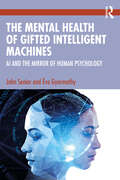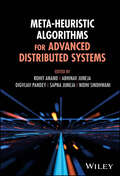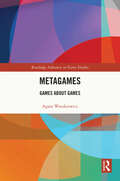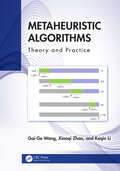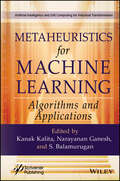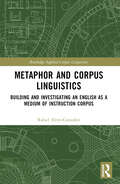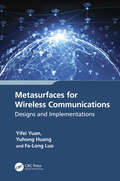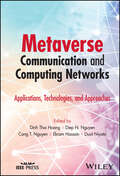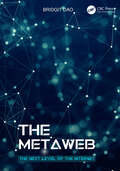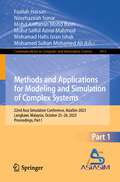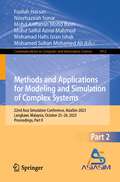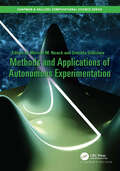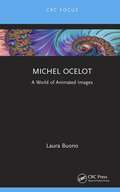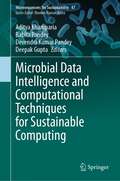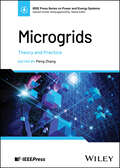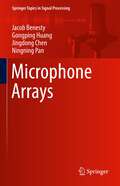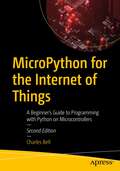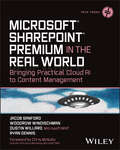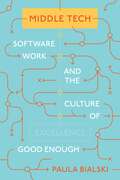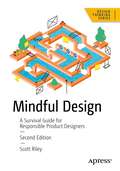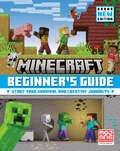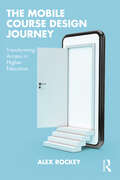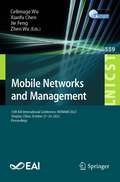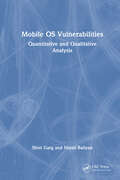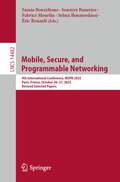- Table View
- List View
The Mental Health of Gifted Intelligent Machines: AI and the Mirror of Human Psychology
by John Senior Éva GyarmathyThe Mental Health of Gifted Intelligent Machines explores the increasingly sophisticated behaviours of developing AI and how we can ensure it will have emotional resilience, ethical strength and an ability to think in a new and enhanced way. Its primary aim is to change how we understand the world by investigating humanity as an intelligent being, examining and contrasting human and artificial intelligence. The book considers what we can learn from the likely mental health issues that will occur with increasingly sophisticated aspects of machine intelligence and how they will reflect the human condition. It asks questions about our identity in a deeply uncertain and disruptive ever-changing world; how we will improve and enhance our psychological intelligence to meet the increasing complications and demands of the future; and what we need to do, now, to be psychologically intelligent enough to live a full meaningful life in a new world evolving around us. The book argues that changes in our understanding of mental health, psychology and our view of intelligence will challenge huge aspects of our fundamental beliefs and assumptions and that it is essential we explore new arenas to further understand both our own human psychological issues and mental health as we develop gifted intelligent machines. It is a must read for all students, researchers and professionals involved with AI, gifted education, consciousness and mental health.
Meta-Heuristic Algorithms for Advanced Distributed Systems
by Rohit Anand Abhinav Juneja Digvijay Pandey Sapna Juneja Nidhi SindhwaniMETA-HEURISTIC ALGORITHMS FOR ADVANCED DISTRIBUTED SYSTEMS Discover a collection of meta-heuristic algorithms for distributed systems in different application domains Meta-heuristic techniques are increasingly gaining favor as tools for optimizing distributed systems—generally, to enhance the utility and precision of database searches. Carefully applied, they can increase system effectiveness, streamline operations, and reduce cost. Since many of these techniques are derived from nature, they offer considerable scope for research and development, with the result that this field is growing rapidly. Meta-Heuristic Algorithms for Advanced Distributed Systems offers an overview of these techniques and their applications in various distributed systems. With strategies based on both global and local searching, it covers a wide range of key topics related to meta-heuristic algorithms. Those interested in the latest developments in distributed systems will find this book indispensable. Meta-Heuristic Algorithms for Advanced Distributed Systems readers will also find: Analysis of security issues, distributed system design, stochastic optimization techniques, and more Detailed discussion of meta-heuristic techniques such as the genetic algorithm, particle swam optimization, and many others Applications of optimized distribution systems in healthcare and other key??industries Meta-Heuristic Algorithms for Advanced Distributed Systems is ideal for academics and researchers studying distributed systems, their design, and their applications.
Metagames: Games about Games (ISSN)
by Agata WaszkiewiczMetagames: Games about Games scrutinizes how various meta devices, such as breaking the fourth wall and unreliable narrator, change and adapt when translated into the uniquely interactive medium of digital games.Through its theoretical analyses and case studies, the book shows how metafictional experimentation can be used to both challenge and push the boundaries of what a game is and what a player’s role is in play, and to raise more profound topics such as those describing experiences of people of oppressed identities. The book is divided into six chapters that deal with the following meta devices: breaking the fourth wall, hypermediation, unreliable narrator, abusive game design, fragmentation, and parody.The book will predominantly interest scholars and students of media studies and game studies as it continues discourses held in the discipline regarding the metareferential character of digital games.
Metaheuristic Algorithms: Theory and Practice
by Gai-Ge Wang Xiaoqi Zhao Keqin LiThis book introduces the theory and applications of metaheuristic algorithms. It also provides methods for solving practical problems in such fields as software engineering, image recognition, video networks, and in the oceans.In the theoretical section, the book introduces the information feedback model, learning-based intelligent optimization, dynamic multi-objective optimization, and multi-model optimization. In the applications section, the book presents applications of optimization algorithms to neural architecture search, fuzz testing, oceans, and image processing. The neural architecture search chapter introduces the latest NAS method. The fuzz testing chapter uses multi-objective optimization and ant colony optimization to solve the seed selection and energy allocation problems in fuzz testing. In the ocean chapter, deep learning methods such as CNN, transformer, and attention-based methods are used to describe ENSO prediction and image processing for marine fish identification, and to provide an overview of traditional classification methods and deep learning methods.Rich in examples, this book will be a great resource for students, scholars, and those interested in metaheuristic algorithms, as well as professional practitioners and researchers working on related topics.
Metaheuristics for Machine Learning: Algorithms and Applications (Artificial Intelligence and Soft Computing for Industrial Transformation)
by Kanak Kalita Narayanan Ganesh S. BalamuruganMETAHEURISTICS for MACHINE LEARNING The book unlocks the power of nature-inspired optimization in machine learning and presents a comprehensive guide to cutting-edge algorithms, interdisciplinary insights, and real-world applications. The field of metaheuristic optimization algorithms is experiencing rapid growth, both in academic research and industrial applications. These nature-inspired algorithms, which draw on phenomena like evolution, swarm behavior, and neural systems, have shown remarkable efficiency in solving complex optimization problems. With advancements in machine learning and artificial intelligence, the application of metaheuristic optimization techniques has expanded, demonstrating significant potential in optimizing machine learning models, hyperparameter tuning, and feature selection, among other use-cases. In the industrial landscape, these techniques are becoming indispensable for solving real-world problems in sectors ranging from healthcare to cybersecurity and sustainability. Businesses are incorporating metaheuristic optimization into machine learning workflows to improve decision-making, automate processes, and enhance system performance. As the boundaries of what is computationally possible continue to expand, the integration of metaheuristic optimization and machine learning represents a pioneering frontier in computational intelligence, making this book a timely resource for anyone involved in this interdisciplinary field. Metaheuristics for Machine Learning: Algorithms and Applications serves as a comprehensive guide to the intersection of nature-inspired optimization and machine learning. Authored by leading experts, this book seamlessly integrates insights from computer science, biology, and mathematics to offer a panoramic view of the latest advancements in metaheuristic algorithms. You’ll find detailed yet accessible discussions of algorithmic theory alongside real-world case studies that demonstrate their practical applications in machine learning optimization. Perfect for researchers, practitioners, and students, this book provides cutting-edge content with a focus on applicability and interdisciplinary knowledge. Whether you aim to optimize complex systems, delve into neural networks, or enhance predictive modeling, this book arms you with the tools and understanding you need to tackle challenges efficiently. Equip yourself with this essential resource and navigate the ever-evolving landscape of machine learning and optimization with confidence. Audience The book is aimed at a broad audience encompassing researchers, practitioners, and students in the fields of computer science, data science, engineering, and mathematics. The detailed but accessible content makes it a must-have for both academia and industry professionals interested in the optimization aspects of machine learning algorithms.
Metaphor and Corpus Linguistics: Building and Investigating an English as a Medium of Instruction Corpus (Routledge Applied Corpus Linguistics)
by Rafael Alejo-GonzálezMetaphor and Corpus Linguistics: Building and Investigating an English as a Medium of Instruction Corpus offers a model for building a corpus of oral EMI seminars. It demonstrates how incorporating metaphor to the process of corpus building affords a more comprehensive description of the role of metaphor in discourse. EMI is the specific context outlined in this volume, and as such it will be of particular interest to researchers in this area, though the design and model can be easily generalised and applied to other corpora focusing on metaphor. Alejo-González argues for the need to build such a corpus given the scarcity of corpora being tagged for metaphor as well as the shortage of those dealing with the EMI phenomenon. This book will be of practical use and interest to those researchers of corpus linguistics or related areas looking to explore metaphor through their corpus studies.
Metasurfaces for Wireless Communications: Designs and Implementations
by Yifei Yuan Yuhong Huang Fa-Long LuoThis book provides a comprehensive coverage of reconfigurable intelligent surface (RIS) based wireless communications by covering all the technology stages from working principles, theories and algorithms, system architectures, real-world implementations, and programming platforms through performance measurements and system testing. Metasurfaces for Wireless Communications: Designs and Implementations serves as a must-be read for everything related to the use of RIS in wireless networks. Authored by three experts in the field, the book is organized into five in-depth and well-designed chapters. The first chapter discusses the fundamentals of metasurfaces for wireless communications as well as the related evolution and requirements of RIS in 6G. The second chapter is devoted to the modeling and analyses of RIS for wireless communications by including electromagnetic field modeling and theoretical analyses of both large- and small-scale channel models. In Chapter 3, the authors mainly address properties’ characterizations and system design of metasurface devices. Chapter 4 examines relay and system implementations of RIS for wireless communications through basic system models, key design aspects, and system simulations and architectures. Chapter 5 discusses the standardization of RIS-aided wireless communications by providing an overview of the relay technologies, field trials, and roadmaps in 3GPP standardizations.This book serves not only as a comprehensive reference for professional engineers, researchers, manufacturers, network operators, software developers, service providers, and regulatory bodies aiming at the development, standardization, deployment, and applications of B5G and 6G mobile communications, but also as a textbook for graduate students in circuits, signal processing, wireless communications, information theory, microwave technology, and antenna and propagation.
Metaverse Communication and Computing Networks: Applications, Technologies, and Approaches
by Dinh Thai Hoang Diep N. Nguyen Cong T. Nguyen Ekram Hossain Dusit NiyatoMetaverse Communication and Computing Networks Understand the future of the Internet with this wide-ranging analysis “Metaverse” is the term for applications that allow users to assume digital avatars to interact with other humans and software functions in a three-dimensional virtual space. These applications and the spaces they create constitute an exciting and challenging new frontier in digital communication. Surmounting the technological and conceptual barriers to creating the Metaverse will require researchers and engineers familiar with its underlying theories and a wide range of technologies and techniques. Metaverse Communication and Computing Networks provides a comprehensive treatment of Metaverse theory and the technologies that can be brought to bear on this new pursuit. It begins by describing the Metaverse’s underlying architecture and infrastructure, physical and digital, before addressing how existing technologies are being adapted to its use. It concludes with an overview of the challenges facing the Metaverse. The result is a thorough introduction to a subject that may define the future of the internet. Metaverse Communication and Computing Networks readers will also find: Detailed treatment of technologies, including artificial intelligence, Virtual Reality, Extended Reality, and more Analysis of issues including data security, ethics, privacy, and social impact A real-world prototype for Metaverse applications Metaverse Communication and Computing Networks is a must-own for researchers and engineers looking to understand this growing area of technology, and entrepreneurs interested in establishing Metaverse businesses.
The Metaweb: The Next Level of the Internet
by Bridgit DAOBuckle up for a fascinating journey through layers of insight and metaphors that explain the past, present, and future of the Web. Readers from all walks of life will learn something ancient, something novel, and something practical. Those who give it careful consideration will never see the Web the same way again. This book proclaims into existence decentralized public space above the webpage that enables the shift from personal to collective computing. The Web's next frontier is the Metaweb, a hyper-dimensional web over Today's Web that connects people and information silos, with accountability and fair value exchange. The Metaweb can drastically reduce false information, abuse, and scams, as well as enable the unprecedented level of collaboration needed to address humanity's global challenges. The book posits a symbiotic relationship between AI and the Metaweb, where AI assists in generating, organizing, and curating content, while the Metaweb provides the necessary constraints, data, and context for AI to function effectively, transparently, and in alignment with humanity. The AI-assisted collaboration among humans on the Metaweb will enable a vast collective intelligence and the capture of tremendous untapped value. For more information go to: http://metawebbook.com
Methods and Applications for Modeling and Simulation of Complex Systems: 22nd Asia Simulation Conference, AsiaSim 2023, Langkawi, Malaysia, October 25–26, 2023, Proceedings, Part I (Communications in Computer and Information Science #1911)
by Fazilah Hassan Noorhazirah Sunar Mohd Ariffanan Mohd Basri Mohd Saiful Azimi Mahmud Mohamad Hafis Izran Ishak Mohamed Sultan Mohamed AliThis book constitutes the refereed proceedings of the 22nd Asia Simulation Conference on Methods and Applications for Modeling and Simulation of Complex Systems, AsiaSim 2023, held in Langkawi, Malaysia, during October 25–26, 2023.The 77 full papers included in this book were carefully reviewed and selected from 164 submissions. They were organized in topical sections as follows: Modelling and Simulation, Artificial intelligence, Industry 4.0, Digital Twins Modelling, Simulation and Gaming, Simulation for Engineering, Simulation for Sustainable Development, Simulation in Social Sciences.
Methods and Applications for Modeling and Simulation of Complex Systems: 22nd Asia Simulation Conference, AsiaSim 2023, Langkawi, Malaysia, October 25–26, 2023, Proceedings, Part II (Communications in Computer and Information Science #1912)
by Fazilah Hassan Noorhazirah Sunar Mohd Ariffanan Mohd Basri Mohd Saiful Azimi Mahmud Mohamad Hafis Izran Ishak Mohamed Sultan Mohamed AliThis book constitutes the refereed proceedings of the 22nd Asia Simulation Conference on Methods and Applications for Modeling and Simulation of Complex Systems, AsiaSim 2023, held in Langkawi, Malaysia, during October 25–26, 2023.The 77 full papers included in this book were carefully reviewed and selected from 164 submissions. They were organized in topical sections as follows: Modelling and Simulation, Artificial intelligence, Industry 4.0, Digital Twins Modelling, Simulation and Gaming, Simulation for Engineering, Simulation for Sustainable Development, Simulation in Social Sciences.
Methods and Applications of Autonomous Experimentation (Chapman & Hall/CRC Computational Science)
by Marcus M. Noack Daniela UshizimaAutonomous Experimentation is poised to revolutionize scientific experiments at advanced experimental facilities. Whereas previously, human experimenters were burdened with the laborious task of overseeing each measurement, recent advances in mathematics, machine learning and algorithms have alleviated this burden by enabling automated and intelligent decision-making, minimizing the need for human interference. Illustrating theoretical foundations and incorporating practitioners’ first-hand experiences, this book is a practical guide to successful Autonomous Experimentation. Despite the field’s growing potential, there exists numerous myths and misconceptions surrounding Autonomous Experimentation. Combining insights from theorists, machine-learning engineers and applied scientists, this book aims to lay the foundation for future research and widespread adoption within the scientific community. This book is particularly useful for members of the scientific community looking to improve their research methods but also contains additional insights for students and industry professionals interested in the future of the field.
Michel Ocelot: A World of Animated Images
by Laura BuonoThis unique book examines the career of Michel Ocelot, from his earliest works to his latest research and productions, including an interview regarding his latest film Le Pharaon, le Sauvage et la Princesse (2022). The book highlights the director’s role in the panorama of contemporary animated cinema and his relationship with the tradition, both artistic and cinematographic. The book carefully analyses the ethical and social nature of Ocelot’s work to underscore the duality of the director’s oeuvre, both artistic and social, using an interdisciplinary approach that blends film and aesthetic criticism with gender studies and decolonial thought. Particular attention will be given to the themes of multiculturalism, discrimination, and treatment of women, which are at the centre of many current cultural debates. The book will be of interest to an audience of experts, animation enthusiasts, and film scholars, as well as to a wider readership interested in learning about the poetics of Kirikou’s father.
Microbial Data Intelligence and Computational Techniques for Sustainable Computing (Microorganisms for Sustainability #47)
by Aditya Khamparia Babita Pandey Devendra Kumar Pandey Deepak GuptaThis book offers information on intelligent and computational techniques for microbial data associated with plant microbes, human microbes etc. The main focus of this book is to provide an insight on building smart sustainable solutions for microbial technology using intelligent computational techniques. Microbes are ubiquitous in nature, and their interactions among each other are important for colonizing diverse habitats. The core idea of sustainable computing is to deploy algorithms, models, policies and protocols to improve energy efficiency and management of resources, enhancing ecological balance, biological sustenance and other services on societal contexts. Chapters in this book explore the conventional methods as well as the most recently recognized high-throughput technologies which are important for productive agroecosystems to feed the growing global population. This book is of interest to teachers, researchers, microbiologist, computer bioinformatics scientists,plant and environmental scientist, and those interested in environment stewardship around the world. The book also serves as an advanced textbook material for undergraduate and graduate students of computer science, biomedicine, agriculture, human science, forestry, ecology, soil science, and environmental sciences and policy makers.
Microgrids: Theory and Practice (IEEE Press Series on Power and Energy Systems)
by Peng ZhangMicrogrids Understand microgrids and networked microgrid systems Microgrids are interconnected groups of energy sources that operate together, capable of connecting with a larger grid or operating independently as needed and network conditions require. They can be valuable sources of energy for geographically circumscribed areas with highly targeted energy needs, and for remote or rural areas where continuous connection with a larger grid is difficult. Microgrids’ controllability makes them especially effective at incorporating renewable energy sources. Microgrids: Theory and Practice introduces readers to the analysis, design, and operation of microgrids and larger networked systems that integrate them. It brings to bear both cutting-edge research into microgrid technology and years of industry experience in designing and operating microgrids. Its discussions of core subjects such as microgrid modeling, control, and optimization make it an essential short treatment, valuable for both academic and industrial study. Readers will acquire the skills needed to address existing problems and meet new ones as this crucial area of power engineering develops. Microgrids: Theory and Practice also features: Incorporation of new cyber-physical system technologies for enabling microgrids as resiliency resources Theoretical treatment of a wide range of subjects including smart programmable microgrids, distributed and asynchronous optimization for microgrid dispatch, and AI-assisted microgrid protection Practical discussion of real-time microgrids simulations, hybrid microgrid design, transition to renewable microgrid networks, and more Microgrids: Theory and Practice is ideal as a textbook for graduate and advanced undergraduate courses in power engineering programs, and a valuable reference for power industry professionals looking to address the challenges posed by microgrids in their work.
Microphone Arrays (Springer Topics in Signal Processing #22)
by Jacob Benesty Gongping Huang Jingdong Chen Ningning PanThis book explains the motivation for using microphone arrays as opposed to using a single sensor for sound acquisition. The book then goes on to summarize the most useful ideas, concepts, results, and new algorithms therein. The material presented in this work includes analysis of the advantages of using microphone arrays, including dimensionality reduction to remove the redundancy while preserving the variability of the array signals using the principal component analysis (PCA). The authors also discuss benefits such as beamforming with low-rank approximations, fixed, adaptive, and robust distortionless beamforming, differential beamforming, and a new form of binaural beamforming that takes advantage of both beamforming and human binaural hearing properties to improve speech intelligibility. The book makes the microphone array signal processing theory and applications available in a complete and self-contained text. The authors attempt to explain the main ideas in a clear and rigorous way so that the reader can easily capture the potentials, opportunities, challenges, and limitations of microphone array signal processing. This book is written for those who work on the topics of microphone arrays, noise reduction, speech enhancement, speech communication, and human-machine speech interfaces.
MicroPython for the Internet of Things: A Beginner’s Guide to Programming with Python on Microcontrollers
by Charles BellThis book will help you quickly learn to program for microcontrollers and IoT devices without a lot of study and expense. MicroPython and controllers that support it eliminate the need for programming in a C-like language, making the creation of IoT applications and devices easier and more accessible than ever. MicroPython for the Internet of Things is ideal for readers new to electronics and the world of IoT. Specific examples are provided covering a range of supported devices, sensors, and MicroPython boards such as the Raspberry Pi Pico and the Arduino Nano Connect RP2040 board. Programming for microcontrollers has never been easier. The book takes a practical and hands-on approach without a lot of detours into the depths of theory. It’ll show you a faster and easier way to program microcontrollers and IoT devices, teach you MicroPython, a variant of one of the most widely used scripting languages, and is written to be accessible to those new to electronics. After completing this book, and its fun example projects, you’ll be ready to ready to use MicroPython to develop your own IoT applications. What You Will Learn Program in MicroPython Understand sensors and basic electronics Develop your own IoT projects Build applications for popular boards such as Raspberry Pi Pico and Arduino Nano Connect RP2040 Load MicroPython on compatible boards Interface with hardware breakout boards Connect hardware to software through MicroPython Explore connecting your microcontroller to the cloud Develop IoT projects for the cloud Who This Book Is For Anyone interested in building IoT solutions without the heavy burden of programming in C++ or C. The book also appeals to those wanting an easier way to work with hardware than is provided by platforms that require more complex programming environments.
Microsoft SharePoint Premium in the Real World: Bringing Practical Cloud AI to Content Management (Tech Today)
by Jacob J. Sanford Woodrow W. Windischman Dustin Willard Ryan DennisSkillfully deploy Microsoft SharePoint Premium to automate your organization’s document processing and management In Microsoft SharePoint Premium in the Real World: Bringing Practical Cloud AI to Content Management, a team of veteran Microsoft AI consultants delivers an insightful and easy-to-follow exploration of how to apply Syntex’ content AI and advanced machine learning capabilities to your firm’s document processing automation project. Using a simple, low-code/no-code approach, the authors explain how you can find, organize, and classify the documents in your SharePoint libraries. You’ll learn to use Microsoft SharePoint Premium to automate forms processing, document understanding, image processing, content assembly, and metadata search. Readers will also find: Strategies for using both custom and pre-built, “off-the-rack” models to build your solutions The information you need to understand the Azure Cognitive Services ecosystem more fully and how you can use it to build custom tools for your organization Examples of solutions that will allow you to avoid the manual processing of thousands of your own documents and files An essential and hands-on resource for information managers, Microsoft SharePoint Premium in the Real World is a powerful tool for developers and non-developers alike.
Middle Tech: Software Work and the Culture of Good Enough (Princeton Studies in Culture and Technology #36)
by Paula BialskiWhy software isn&’t perfect, as seen through the stories of software developers at a run-of-the-mill tech companyContrary to much of the popular discourse, not all technology is seamless and awesome; some of it is simply &“good enough.&” In Middle Tech, Paula Bialski offers an ethnographic study of software developers at a non-flashy, non-start-up corporate tech company. Their stories reveal why software isn&’t perfect and how developers communicate, care, and compromise to make software work—or at least work until the next update. Exploring the culture of good enoughness at a technology firm she calls &“MiddleTech,&” Bialski shows how doing good-enough work is a collectively negotiated resistance to the organizational ideology found in corporate software settings.The truth, Bialski reminds us, is that technology breaks due to human-related issues: staff cutbacks cause media platforms to crash, in-car GPS systems cause catastrophic incidents, and chatbots can be weird. Developers must often labor to patch and repair legacy systems rather than dream up killer apps. Bialski presents a less sensationalist, more empirical portrait of technology work than the frequently told Silicon Valley narratives of disruption and innovation. She finds that software engineers at MiddleTech regard technology as an ephemeral object that only needs to be good enough to function until its next iteration. As a result, they don&’t feel much pressure to make it perfect. Through the deeply personal stories of people and their practices at MiddleTech, Bialski traces the ways that workers create and sustain a complex culture of good enoughness.
Mindful Design: A Survival Guide for Responsible Product Designers (Design Thinking)
by Scott RileyLearn to create seamless designs backed by a responsible understanding of the human mind. This new edition is fully updated and reworked to employ a realistic, challenging, and practical approach to interface design, presenting state of the art scientific studies in behavioral sciences, interface design and the psychology of design. All with modern, up-to-date examples and screenshots. The practical portion of this edition has been completely reworked, giving you the chance to follow along with a real, proven design process that has produced several successful products imbued with the principles of mindful, responsible design.You'll examine how human behavior can be used to integrate your product design into lifestyle, rather than interrupt it, and make decisions for the good of those that are using your product. You will also learn about the neurological aspects and limitations of human vision and perception; about our attachment to harmony and dissonance; and about our brain’s propensity towards pattern recognition and how we perceive the world around us. In the second half of the book, you’ll follow along with the key phases of a design project, implementing what you have learned in an end-to-end, practical setting. Design is a responsibility, but not enough designers understand the human mind or the process of thought. Mindful Design, Second Edition introduces the areas of brain science that matter to designers, and passionately explains how those areas affect each human’s day-to-day experiences with products and interfaces, providing a battle-tested toolkit to help you make responsible design decisions. What You'll Learn Review how attention and distraction work and the cost of attentional switchingUse Gestalt principles to communicate visual groupingEnsure your underlying models make sense to your audienceUse time, progression, and transition to create a compositionCarefully examine controlling behavior through reductionist and behaviorist motivation concepts Apply the theoretical knowledge to practical, mindful interface design Who This Book Is For The primary audience for this book is professional designers who wish to learn more about the human mind and how to apply that to their work. The book is also useful for design-focused product owners and startup founders who wish to apply ethical thinking to a team, or when bootstrapping their products. The secondary audience is design students who are either studying a ‘traditional’ visual design course, or a UX/interaction design course who have a desire to learn how they might be able to apply mindful design to their early careers. Finally, a tertiary audience for this book would be tutors involved in teaching design, or peripheral, courses who may wish to incorporate its teachings into their lectures, workshops or seminars.
Minecraft: Beginner's Guide (Minecraft)
by Mojang AB The Official Minecraft TeamDive into Minecraft headfirst with this all-new beginner&’s guide that will teach you everything you need to know for starting your Minecraft journey, whether that be in Survival mode or Creative. Are you new to Minecraft or still not quite getting the hang of it? Then this book is for you! Join characters such as Miss Hap, Sir Vival and Bill Ding on an adventure through the Overworld, to discover how you can ace your early game.Learn everything from what happens when you die and how to avoid it to how to feed yourself and where to find the cutest mobs. So what are you waiting for? Pick up the book and start your epic adventure!Full of fun and humor, this guide is perfect for kids of all ages.
The Mobile Course Design Journey: Transforming Access in Higher Education
by Alex RockeyThe Mobile Course Design Journey provides practical strategies to college and university educators and faculty support professionals looking to develop accessible mobile learning experiences. Given the near-ubiquity of mobile device ownership today, creating courses that can be completed entirely on a mobile device is essential to captivating student attention and supporting equity-minded pedagogy. This book frames effective mobile design within a continuum in which educators can make gradual yet meaningful changes to their instruction and course content while leveraging learners’ existing tools and literacies. Original, ready-to-use features such as a rubric for evaluating the mobile-friendliness of course content and assignments as well as a toolkit for leading workshops on mobile design will further help to demystify mobile learning in higher education.
Mobile Networks and Management: 13th EAI International Conference, MONAMI 2023, Yingtan, China, October 27-29, 2023, Proceedings (Lecture Notes of the Institute for Computer Sciences, Social Informatics and Telecommunications Engineering #559)
by Celimuge Wu Xianfu Chen Jie Feng Zhen WuThis book constitutes the refereed post-conference proceedings of the 13th International Conference on Mobile Networks and Management, MONAMI 2023, held in Yingtan, China, in October 2023. The 21 full papers were carefully reviewed and selected from 41 submissions. The papers are divided into groups of content as follows: Wireless Communication and Networks; Network Security and Blockchain; Image Processing and Computer Vision; Distributed Computing; Emerging Applications.
Mobile OS Vulnerabilities: Quantitative and Qualitative Analysis
by Shivi Garg Niyati BaliyanThis is book offers in-depth analysis of security vulnerabilities in different mobile operating systems. It provides methodology and solutions for handling Android malware and vulnerabilities and transfers the latest knowledge in machine learning and deep learning models towards this end. Further, it presents a comprehensive analysis of software vulnerabilities based on different technical parameters such as causes, severity, techniques, and software systems’ type. Moreover, the book also presents the current state of the art in the domain of software threats and vulnerabilities. This would help analyze various threats that a system could face, and subsequently, it could guide the securityengineer to take proactive and cost-effective countermeasures. Security threats are escalating exponentially, thus posing a serious challenge to mobile platforms. Android and iOS are prominent due to their enhanced capabilities and popularity among users. Therefore, it is important to compare these two mobile platforms based on security aspects. Android proved to be more vulnerable compared to iOS. The malicious apps can cause severe repercussions such as privacy leaks, app crashes, financial losses (caused by malware triggered premium rate SMSs), arbitrary code installation, etc. Hence, Android security is a major concern amongst researchers as seen in the last few years. This book provides an exhaustive review of all the existing approaches in a structured format. The book also focuses on the detection of malicious applications that compromise users' security and privacy, the detection performance of the different program analysis approach, and the influence of different input generators during static and dynamic analysis on detection performance. This book presents a novel method using an ensemble classifier scheme for detecting malicious applications, which is less susceptible to the evolution of the Android ecosystem and malware compared to previous methods. The book also introduces an ensemble multi-class classifier scheme to classify malware into known families. Furthermore, we propose a novel framework of mapping malware to vulnerabilities exploited using Android malware’s behavior reports leveraging pre-trained language models and deep learning techniques. The mapped vulnerabilities can then be assessed on confidentiality, integrity, and availability on different Android components and sub-systems, and different layers.
Mobile, Secure, and Programmable Networking: 9th International Conference, MSPN 2023, Paris, France, October 26–27, 2023, Revised Selected Papers (Lecture Notes in Computer Science #14482)
by Samia Bouzefrane Soumya Banerjee Fabrice Mourlin Selma Boumerdassi Éric RenaultThis book constitutes the refereed post-proceedings of the 9th International Conference on Mobile, Secure, and Programmable Networking, MSPN 2023, held in Paris, France, during October 26–27, 2023.The 15 full papers included in this book were carefully reviewed and selected from 31 submissions. They were organized in topical sections as follows vertical tools on machine leaning and artificial intelligence, network programming and Cloud computing, Industrial Internet of things, Digital Twins and Security.
